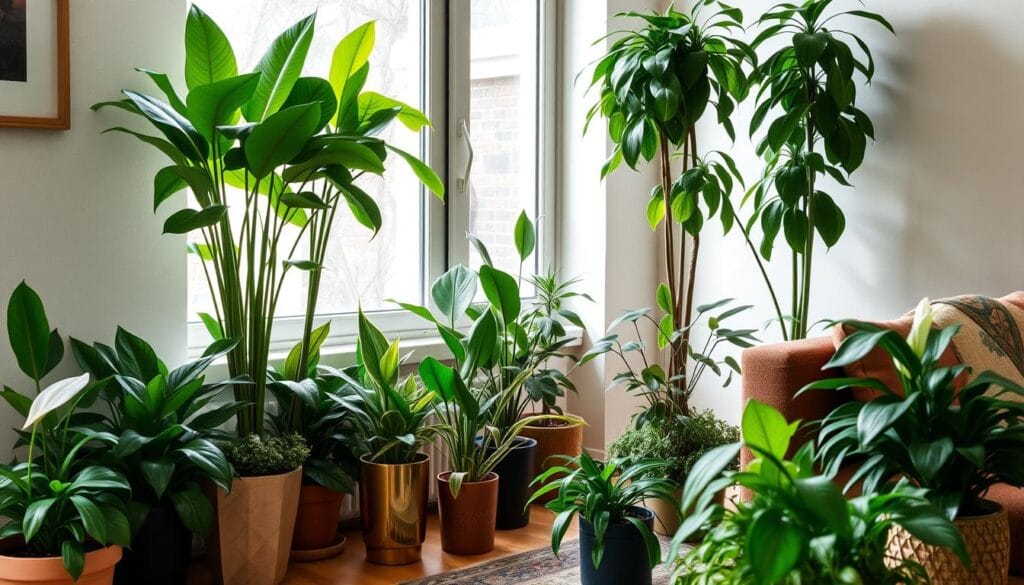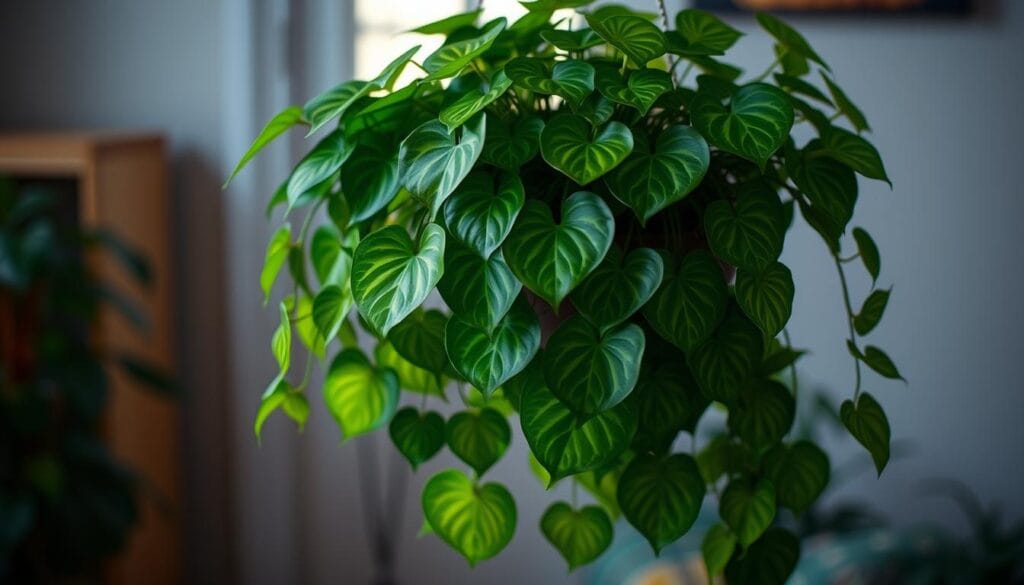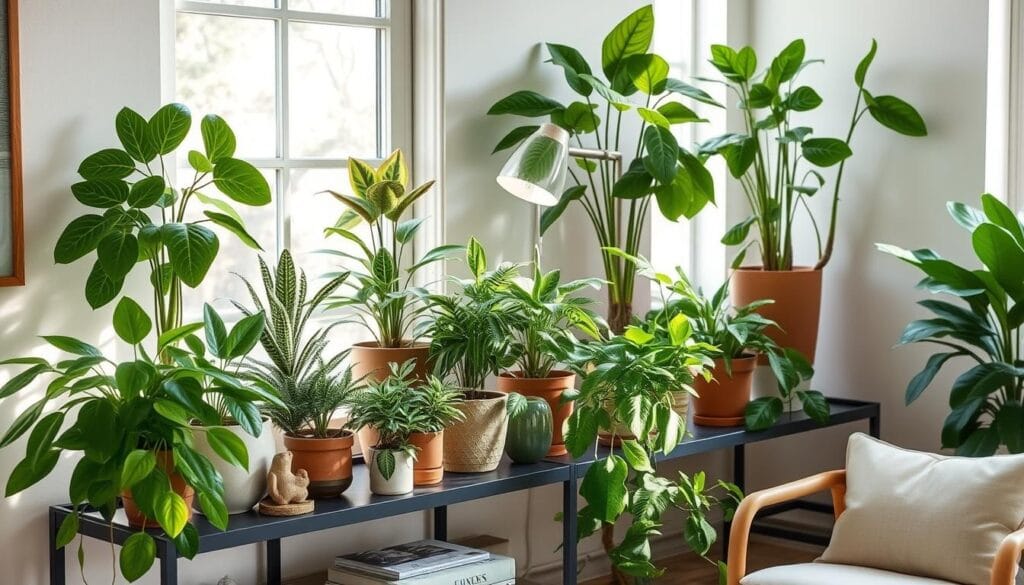Finding the right indoor plants for low-light areas can be tough. But, this guide will show you the 10 best plants for dim spaces. They’ll help you add life and greenery to your home or office, even with little light.

Plants like the Snake Plant and Chinese Evergreen are perfect for low light. They can improve your décor, clean the air, and make any room feel calm. Learn about each plant’s special traits, care needs, and benefits. This will help you create a beautiful, green space, even in the darkest corners.
Table of Contents
Key Takeaways
- Discover 10 of the best indoor plants for low-light conditions
- Learn about the unique traits and care needs of each plant
- Understand how to transform your indoor space with the right low-light plants
- Explore the air-purifying benefits of these resilient houseplants
- Gain tips for styling and maintaining your low-light plant collection
Understanding Low Light Conditions in Indoor Spaces
Indoor gardening and plant care need a good grasp of low light conditions. Whether you aim for a lush indoor landscape or want to keep houseplants alive, knowing how to manage low light is essential. We’ll dive into measuring light, finding the right spots for plants, and the differences between natural and artificial light.
Measuring Light Levels in Your Home
To start a successful indoor garden, you must measure your home’s light levels. Use a light meter or a smartphone app for this. By checking different spots, you’ll find where light is most and least present. This info helps choose the right indoor gardening and plant care for your indoor landscaping.
Identifying Suitable Spots for Plants
- Look for spots near windows or skylights with indirect, filtered light.
- Stay away from direct sunlight to prevent scorching plant leaves.
- Use mirrors or light-colored walls to reflect and increase available light.
- Try different placements to find the right mix of light and shade for your plants.
Natural vs. Artificial Light Sources
Natural sunlight is best for most indoor plants, but sometimes artificial light is needed. LED and fluorescent bulbs work well for low light plants. It’s key to know the strengths and weaknesses of each light type. This knowledge helps you create the best environment for your indoor gardening and plant care.
“The key to successful indoor landscaping is understanding and managing the light conditions in your space.”
Best Indoor Plants for Low Light Environments
Bringing nature indoors can be very rewarding, even in places with little sunlight. There are many potted plants, low light plants, and indoor greenery that do well in dim or shaded areas. Let’s look at the top 10 indoor plants that love low light.
- Snake Plant – Also known as Mother-in-Law’s Tongue, this hardy succulent can tolerate a wide range of lighting conditions, making it an excellent choice for low-light areas.
- ZZ Plant – Renowned for its ability to survive even in the darkest corners, the ZZ plant is a low-maintenance option that adds a touch of lush greenery to your indoor space.
- Pothos – This trailing vine is a versatile indoor greenery option, thriving in low light and adding a touch of natural elegance to any room.
- Chinese Evergreen – With its unique leaf patterns and adaptability to various light conditions, the Chinese Evergreen is a stunning and low-maintenance potted plant choice.
- Philodendron – These fast-growing, lush-leaved plants can flourish in low-light environments, making them a popular pick for indoor greenery enthusiasts.
- Dracaena – Offering a range of vibrant foliage options, Dracaena plants are resilient and can tolerate less-than-ideal lighting conditions.
- Peace Lily – Known for its elegant white blooms, the Peace Lily thrives in shaded areas and can even help purify the air in your home.
- English Ivy – This versatile trailing plant not only looks beautiful but can also adapt to low-light settings, making it a great choice for potted plants.
- Cast Iron Plant – As the name suggests, this plant is incredibly resilient and can withstand a range of lighting conditions, including low-light environments.
- Sansevieria – Also called the “Mother-in-Law’s Tongue,” this succulent variety is a top-performer in low light plants and can add a striking visual element to your indoor space.
Choosing from this diverse selection of indoor greenery options, you can bring nature’s calm into your home, even in dim areas. With proper care, these plants will flourish and beautify your spaces.

“Low-light plants are the unsung heroes of indoor gardening, quietly thriving in the shadows and adding a touch of verdant beauty to any space.”
Snake Plant: The Ultimate Survivor
The snake plant is a top pick for indoor plants that don’t need much light. It’s known for its striking leaves and ability to clean the air. This plant is perfect for anyone who wants a low-care addition to their home.
Care Requirements for Snake Plants
Snake plants, also known as Sansevieria, love being ignored. They only need water when the soil is dry. These plants can handle different light levels, from bright to very dim.
They only need a few fertilizations a year, during their growing season.
Varieties of Snake Plants
The snake plant family has many varieties, each with its own look. You can find tall, upright leaves or more compact plants. Some popular ones are ‘Laurentii’ with yellow edges and ‘Moonshine’ with a silver look.
Propagation Methods
- Division: Snake plants can be easily propagated by dividing the rhizome-like roots and repotting the offsets.
- Plant propagation via leaf cuttings: Simply snip a healthy leaf, allow the cut end to callus over, and plant it in well-draining soil.
- Seed propagation: While less common, snake plants can also be grown from seeds, though this method is more time-consuming.
Snake plants are great for those who want easy-to-care-for, air-purifying plants. They’re perfect for both plant experts and beginners. Adding a snake plant to your home is a smart choice.

ZZ Plant: A Low-Maintenance Champion
Looking for a hardy houseplant that does well in low light? The ZZ plant is your answer. It’s perfect for those who don’t have much time for plant care or are new to houseplants.
The ZZ plant, also known as Zamioculcas zamiifolia, comes from eastern Africa. It’s known for its ability to handle different light levels. It does well in both bright, indirect light and dim corners, making it a favorite among houseplants, plant care, and indoor greenery fans.
Its thick, waxy leaves can store water, helping it survive without water for a while. This is great for people who often forget to water their plants or have trouble keeping the soil moist. The ZZ plant is a low-maintenance winner for those with little time for plant care.
| Characteristic | Description |
|---|---|
| Light Requirements | Thrives in low-light conditions, but can also tolerate bright, indirect sunlight |
| Watering Needs | Requires infrequent watering, with the soil allowed to dry out between waterings |
| Growth Habit | Produces thick, glossy, and graceful leaves that can reach up to 3 feet in height |
| Toxicity | Mildly toxic to pets, so it’s best to keep it out of reach of curious animals |
Whether you’re a seasoned plant parent or just starting, the ZZ plant is a great choice. Its easy care and adaptability to various light conditions make it a standout among indoor plants.

Pothos: The Versatile Vine
Looking for a low-maintenance plant for your indoor spaces? The Pothos is a great choice. It’s a trailing vine that loves many light conditions, even the dim ones. Its lush foliage and easy care make it perfect for both new and seasoned plant lovers.
Different Pothos Varieties
Pothos has many varieties, each with its own beauty. You can find the classic golden Pothos or the Marble Queen with its striking patterns. The Neon Pothos has bright green leaves, and the Pearls and Jade Pothos has a mix of green, white, and silver.
Training and Pruning Tips
- Train your Pothos to climb up a trellis or moss pole for a captivating vertical display.
- Prune wayward vines regularly to maintain a neat and tidy appearance.
- Use sharp, clean scissors or pruners to snip off any dead or damaged leaves, promoting healthy plant propagation.
Common Growth Problems
Pothos is mostly easy to care for, but it can face some issues. Yellow or brown leaves might mean it’s getting too much or too little water. If the leaves are wilting or drooping, it might need more light. Keep an eye on your Pothos and adjust its care to help it grow well indoors.

“Pothos is the perfect plant for those who want the beauty of lush, trailing foliage without the hassle of high-maintenance care.”
Chinese Evergreen: Beautiful and Adaptable
The Chinese Evergreen is a stunning indoor plant that does well in many light conditions. It’s perfect for anyone who loves indoor plants. Its vibrant leaves add a natural beauty to any room.
This plant is easy to care for and can handle different light levels. It can even do well in low-light spaces. This makes it great for homes or offices with little natural light.
The Chinese Evergreen is also good at cleaning the air. It can remove harmful toxins like formaldehyde and benzene. This makes it a smart pick for better indoor air.
There are many varieties of Chinese Evergreen, each with unique leaves and colors. You can find one that matches your style and decor. For example, the ‘Aglo’ has speckled leaves, while the ‘Silver Queen’ has silver-green leaves.
| Variety | Leaf Color | Light Requirements |
|---|---|---|
| Aglo | Vibrant, speckled leaves | Bright, indirect light |
| Silver Queen | Silver-green hues | Low to medium light |
| Emerald | Solid green leaves | Medium to bright light |
Whether you’re new to indoor plants or have a lot of experience, the Chinese Evergreen is a great choice. It’s beautiful, adaptable, and helps purify the air. With the right care, it can make any indoor space feel more natural and elegant.

Essential Care Tips for Indoor Plants
Keeping your indoor plants healthy and strong needs careful attention. This includes knowing how to water, manage humidity, and when to fertilize. These tips will help your plants do well in your home.
Watering Guidelines
Watering your plants right is key. Water them when the top inch of soil feels dry. Don’t let the soil get too dry, as it can harm the plants. But, too much water can cause root rot. So, check the soil often and adjust your watering as needed.
Humidity Requirements
Many indoor plants like higher humidity, especially those that don’t need much light. You can use a pebble tray, a humidifier, or mist them to keep the humidity right. Make sure to know what each plant needs to keep them moist enough.
Fertilization Schedule
- Give your plants a balanced, water-soluble fertilizer every 4-6 weeks in spring and summer.
- Stop fertilizing in winter when plants grow less.
- Change the fertilizer strength based on your plant’s needs and container size.
By following these care tips, you can make a great home for your indoor plants. They’ll grow well and add beauty to your space.

Common Problems and Solutions
A healthy plant is a happy plant. But, even the best indoor gardeners face challenges. Plant maintenance, indoor gardening, and plant care are key to keeping plants alive indoors.
Yellowing leaves are a common problem. It can be due to too much or too little water, or not enough nutrients. To fix this, watch how much water your plants need and feed them right.
- Stick your finger into the soil to check its moisture level before watering.
- Use a balanced, plant care fertilizer every few weeks to ensure your plants are getting the essential nutrients they need.
Root rot is another issue. It happens when plants sit in too much water. Make sure your pots drain well and don’t let plants sit in water. If you think your plant has root rot, check the roots and might need to repot it.
Pests can also be a problem. Watch your plants closely for pests. If you find pests, try using neem oil or introducing beneficial insects to your garden.
“The key to successful indoor gardening is understanding your plants’ needs and addressing any problems promptly.”
By being careful and fixing problems early, your indoor plants will do well. They’ll bring nature’s beauty into your home.

Decorating with Low Light Plants
Low-light plants are a game-changer for indoor landscaping. They thrive in dim spaces and bring natural beauty and calm to your home. You can use them in plant decor and terrariums to enhance your space.
Styling Tips and Arrangements
Low-light plants are versatile and fun to style. Hang pothos vines from shelves or in baskets for a waterfall look. Group snake plants on tables or shelves for a sleek, modern vibe.
Use Chinese evergreens near windows or in corners. They add color and texture to your indoor landscaping.
Best Containers and Pots
- Choose containers with good drainage, like ceramic or terracotta, to keep your plants healthy.
- Try using vintage or decorative items, like glass jars or metal containers, for a unique look.
- Play with different shapes and sizes for interesting displays. But think about the plant’s needs too.
Low-light plants can turn your home into a lush oasis. Get creative with your plant decor and make your indoor landscaping stand out.

Air-Purifying Benefits of Indoor Plants
Indoor air purifying plants are more than just decorations. They can clean the air in your home. Studies show that some houseplants can remove harmful toxins, making the air healthier.
The Snake Plant is famous for cleaning the air, even at night. It turns carbon dioxide into oxygen. The ZZ Plant also cleans the air, removing benzene and formaldehyde, even in low light.
- Snake Plant: Converts carbon dioxide into oxygen, even at night
- ZZ Plant: Removes benzene and formaldehyde from the air
- Pothos: Effectively filters out formaldehyde and other volatile organic compounds (VOCs)
- Chinese Evergreen: Absorbs airborne toxins like benzene and trichloroethylene
By placing these air purifying plants in your home, you make it healthier. They also add beauty and are easy to care for. They can grow well in low light, fitting many spaces.
| Plant | Air-Purifying Capabilities | Light Requirements |
|---|---|---|
| Snake Plant | Converts CO2 to oxygen, removes formaldehyde | Tolerates low light |
| ZZ Plant | Removes benzene and formaldehyde | Thrives in low light |
| Pothos | Filters out formaldehyde and other VOCs | Adaptable to various light conditions |
| Chinese Evergreen | Absorbs benzene and trichloroethylene | Tolerates low light |
Adding these air purifying plants to your home improves air quality and looks. They are easy to care for and grow well in low light conditions. This makes them a great choice for enhancing your home’s health and beauty.

“Incorporating air-purifying plants into your home or office is an easy and natural way to improve indoor air quality and create a healthier living environment.”
Seasonal Care and Maintenance
Keeping your low-light indoor plants healthy needs some seasonal care. In winter, when sunlight is less, watch your watering closely. Don’t overwater to avoid root rot. Water less often and let the soil dry a bit before watering again.
Winter Care Guidelines
In winter, plants often need less food. Stop fertilizing and just water right. Watch for signs of stress like yellow leaves or wilting. Adjust their care if you see these signs.
Summer Adjustments
Summer brings more heat and light. Your plants might need more water and misting. Watch for changes in growth or leaves. You might need to move them to a brighter spot.
Repotting Schedule
Check your plants’ roots often and repot every 2-3 years. This lets them grow and get nutrients. Use a bigger pot and a mix made for indoor plants when you repot.
FAQ
What are the best indoor plants for low light conditions?
The best plants for low light are the Snake Plant, ZZ Plant, Pothos, Chinese Evergreen, and Peace Lily. They do well in places with little natural light.
How do I measure the light levels in my home?
Use a light meter or a light-measuring app on your phone to check light levels. This helps find the darkest spots and pick the right plants.
What are the care requirements for low-light indoor plants?
Low-light plants need less water and fertilizer than sun-loving plants. Don’t overwater and fertilize with a balanced, low-dose mix every few months.
How do I propagate my indoor plants?
You can grow more plants by taking stem cuttings or dividing them. This is a simple way to share plants or add more to your home.
What are the air-purifying benefits of indoor plants?
Indoor plants, including low-light ones, clean the air by removing toxins and adding oxygen. The Snake Plant, Peace Lily, and Chinese Evergreen are top air purifiers.
How can I decorate with low-light indoor plants?
Use low-light plants to beautify your home. Hang them in baskets, place them on shelves, or in decorative containers and terrariums.
How do I care for my indoor plants during the different seasons?
Adjust watering, light, and fertilizer as the seasons change. In winter, water less and add more light. In summer, water more and move plants to brighter spots.





